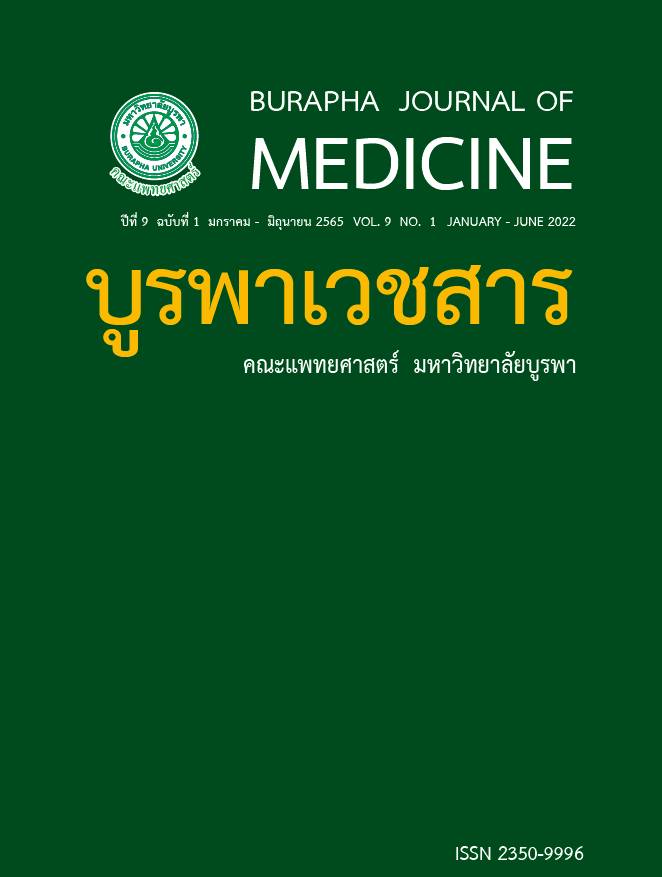การศึกษาถึงความสำคัญสารก่อภูมิแพ้ในเด็กที่ป่วยเป็นโรคภูมิแพ้จมูกอักเสบจากภาคตะวันออกของประเทศไทย
คำสำคัญ:
เยื่อบุจมูกอักเสบจากภูมิแพ้, ความชุกของสารก่อภูมิแพ้ในอากาศบทคัดย่อ
บริบท อุบัติการณ์โรคภูมิแพ้จมูกอักเสบสูงขึ้นทั่วโลกรวมทั้งประเทศไทยสารก่อภูมิแพ้เป็นปัจจัยสำคัญในการ
เกิดโรค ข้อมูลการแพ้สารก่อภูมิแพ้ในอากาศภาคตะวันออกของประเทศไทยยังมีไม่มากจึงเป็นที่มาของการศึกษา
วัตถุประสงค์ ศึกษาการแพ้สารก่อภูมิแพ้ในผู้ป่วยเด็กโรคเยื่อบุจมูกอักเสบจากภูมิแพ้ โรงพยาบาลมหาวิทยาลัยบูรพาย้อนหลัง 5 ปีตั้งแต่ พ.ศ.2559-2563
วิธีการศึกษา ศึกษาย้อนหลังเชิงพรรณนา ในผู้ป่วยเด็กโรคภูมิแพ้จมูกอักเสบอายุ 2-15 ปี 100 ราย ที่คลินิกโรคภูมิแพ้โรงพยาบาลมหาวิทยาลัยบูรพา เก็บข้อมูลพื้นฐาน ตัวโรควิเคราะห์ข้อมูลด้วยสถิติเชิงพรรณนา Chi-square tests และ and Fisher’s exact tests
ผลการศึกษา อายุเฉลี่ย 9.63 ± 3.14 ปี สารก่อภูมิแพ้ที่ให้ผลบวกมากที่สุด 3 ลำดับแรก ได้แก่ Dermatophagoides pteronyssinus (Dp) (ร้อยละ 90) รองลงมา D. Farinae (ร้อยละ 68) และ American
cockroach (ร้อยละ 33) ส่วนสารก่อภูมิแพ้อื่นๆ German cockroach, Cat dander, Bermuda, Careless weed, Dog dander, Acacia, Aspergillus, Cladosporium, Alternaria, Johnson grass, Para grass พบร้อยละ 23, 16, 13, 13, 12, 12, 12, 11, 8, 7 และ 7 ตามลำดับ ผู้ป่วยที่แพ้สารก่อภูมิแพ้มากกว่า 1 ชนิด พบ โรคร่วมมากกว่ากลุ่มที่แพ้เพียง 1 ชนิด 1.92 เท่า แต่ไม่พบความแตกต่างอย่างมีนัยสำคัญ (ร้อยละ 52.17 และ ร้อยละ 35.48, OR 1.92, 95% CI 0.80-4.63, p = 0.14) ผู้ป่วยที่มีโรคร่วมเยื่อบุตาอักเสบจากภูมิแพ้ แพ้ไรฝุ่น
มากที่สุด (ร้อยละ 96.55) การประเมินความรุนแรงของโรคตาม ARIA classification พบ mild persistent AR มากที่สุด (ร้อยละ 86) ทุกคนในกลุ่ม moderate-severe persistent AR ใช้ยาสเตียรอยด์พ่นจมูกอย่างสม่ำเสมอเมื่อเทียบกับกลุ่มที่รุนแรงน้อยกว่า (ร้อยละ 100 และ ร้อยละ 51.7, p = 0.03), กลุ่ม mild intermittent AR
มีอัตราการหายจากโรคสูงกว่ากลุ่ม moderate-severe persistent AR (ร้อยละ 100 และ ร้อยละ 14.3, p = 0.003) อย่างมีนัยสำคัญ
สรุป ไรฝุ่นเป็นสารก่อภูมิแพ้ที่พบมากที่สุดในผู้ป่วยเด็กโรคภูมิแพ้จมูกอักเสบในภาคตะวันออกของประเทศไทยคล้ายกับการศึกษาที่ผ่านมาในภูมิภาคอื่นในประเทศ พบการแพ้สารก่อภูมิแพ้นอกบ้านมากกว่าการศึกษาที่ผ่านมา (grasses, weeds, molds เช่น Cladosporium และ Alternaria) พบการแพ้รังแคแมวและรังแคสุนัขมากขึ้น
เอกสารอ้างอิง
Asher MI, Montefort S, Bjorksten B, Lai Ck, StrachanDP, WeilandSK, et al. Worldwide time trends in the prevalence of symptoms
of asthma, allergic rhinoconjunctivitis, and eczema in childhood: ISAAC phases one and three repeat multicounty crosssectional surveys. Lancet. 2006; 368: 733- 43.
Bjorksten B, Clayton T, Ellwood P, Stewart A, Strachan D, ISAAC Phase III Study Group. Worldwide time trends for symptoms
of rhinitis and conjunctivitis: phase III of the International Study of Asthma and Allergies in Childhood. Pediatr Allergy
Immunol. 2008; 19: 110-24.
Bousquet J, Cauwenberge PV, Khaltaev N, Annesi I, Bachert C, Bateman E, et al. World Health Organization Initiative Allergic
rhinitis and its impact on asthma (ARIA). ARIA exe summary-Vancouver. 2000: 1-38.
Bunnag C, Jareoncharsri P, Tantilipikorn P, Vichyanond P, Pawankar R. Epidemiology and current status of allergic rhinitis and asthma in Thailand. ARIA Asia Pacific Workshop report. Asian Pac J Allergy Immunol. 2009; 27: 79-86.
Arshad SH, Tariq SM, Matthews S, Hakim E. Sensitization to common allergens and its association with allergic disorders at age
years: a whole population birth cohort study. Pediatrics. 2001; 108. e33.
Kihlström A, Lilja G, Pershagen G, Hedlin G. Exposure to birch pollen in infancy and development of atopic disease in childhood. J Allergy Clin Immunol. 2002; 110: 78-84.
Arruda LK, Rizzof MC, Chapman MD, Caldaz EF, Baggioj D, Mill TP, Naspitz, et al. Exposure and sensitization to dust mite
allergens among asthmatic children in Sao Paulo, Brazil. Clin. Exp. Allergy. 1991; 21: 433-9.
Amato Gd, Cecchi L, Bonini S, Nunes C, Annesi I, Behrendt H, et al. Allergenic pollen and pollen allergy in Europe.
Allergy. 2007; 62: 976–90.
Perzanowski MS, Ronmark E, Nold B, Lundback B, Platts-Mills T. Relevance of allergens from cats and dogs to asthma in the northernmost province of Sweden: Schools as a major site of exposure. J Allergy Clin Immunol. 1999; 103: 1018-24.
Pumhirun P, Towiwat P, Mahakit P. Aeroallergen Sensitivity of Thai Patients with Allergic Rhinitis. Asian Pac J Allergy
Immunol. 1997; 15: 183-5.
Kongpanichkul A. Vichyanond P, Tuchinda M. Allergen skin test reactivities among asthmatic Thai chil dren. J Med Assoc Thai.
; 80: 69-75.
Ngamphaiboon J, Boonpirak B, Chatchatee P. Intradermal shin testing in a aeroallergic Thai children.Chula Med J. 1998; 42;
-13.
Trakuttivakorn M. Prevatence of allergen skin test positivities in children with asthma and attergic rhinitis at Maharaj
Nakorn Chiang Mai Hospital. Thai J Pediatr. 2000; 39: 195-203.
Sritipsukho P. Aeroallergen Sensitivity Among Thai Children with Allergic respiratory Distress. Asian Pac J Allergy Immunol. 2004; 22: 91-5.
Tongloh S. Allergen Skin test reactivities in children with allergic rhinitis allergic conjunctivitis atopic dermatitis and asthma
at Surin Hospital. Med J Srisaket Surin Buriram Hosp. 2011; 26: 263-73.
Oncham S, Tongdee M, Dachaprapapitak N, Kafaksom T, Wongsa C, Laisuan W.Prevalence of Aeroallergen Sensitization
from Skin Prick Test in Allergy Clinic at Ramathibodi Hospital. RMJ. 2018; 41: 9-15.
Kulpradittarom B, Sumitsawan Y. Guideline for allergic rhinitis in adult in Thailand. Thai J Otolaryngol Head Neck Surg. 2001; 2: 4-5.
Kongpanitkul A. Allergy skin testing. In: Vichyanond P, Potikumjorn P, Rakrungtham K, editors. Allergy 2000’s. 2nd ed. Bangkok:
Chuanpim Printing Office; 2004: 139-62.
Thampanitwong P. Specificity and sensitivity of skin prick test in diagnosis of allergic rhinitis sensitized by cockroach. Bangkok: Chulalongkorn University Printing House; 2000.
Chinratanapisit S, Suratannon N, Pacharn P, Sritipsukho P, Vichyanond P. Prevalence and severity of asthma, rhinoconjunctivitis
and eczema in children from the Bangkok area: The Global Asthma Network (GAN) Phase I. Asian Pac J Allergy Immunol. 2019;
: 226-31.
Ibanez MD, Valero AL, Montoro J, Jauregui I, Ferrer M, Davila I, et al. Analysis of comorbidities and therapeutic approach for allergic rhinitis in a pediatric population in Spain. Pediatr Allergy Immunol. 2013; 24: 678–84.



